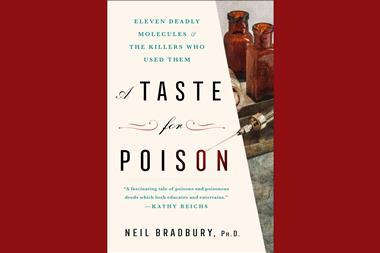Meera Senthilingam
This week's compound could have shaken up some Shakespeare:
Duncan McMillan
'Eye of newt, and toe of frog,
Wool of bat, and tongue of dog,
Adder's fork, and blind-worm's sting,
Lizard's leg, and howlet's wing,--
For a charm of powerful trouble,
Like a hell-broth boil and bubble'
The three witches in Macbeth might have been saved a good deal of effort sourcing these hard-to-find ingredients if they had instead boiled a bucket of ants. 60 years after the Scottish play's first performance, the English naturalist John Ray decided to do exactly that, and produced a handy hell-broth of his own.
Ant hills had long been known to emit acidic vapour when Ray attempted his somewhat brutal distillation, but it is thanks to him that the source was discovered. As Ray noted, in a 1670 letter to the Royal Society's Philosophical Transactions, he was prompted to investigate on consulting Langham's Garden of Health, where he met with the passage: 'Cast the flowers of chicory among an heap of Ants, and they will soon become as red as blood.'

Chicory flowers are known to change colour according to soil pH, and they seemed to have served to the natural philosophers of Ray's era as handy natural litmus paper. Having repeated the experiment, flowers in hand, Ray wrote: "as [the ants] creep, they let fall a drop of liquor from them, and where that chances to light, there you shall have in a moment a large red stain... To what sort of liquor to refer this Juyce, I know not." That name would come in due course, since methanoic acid, the key ingredient that stained the chicory flowers red that day, was later named for the ants that gave it up - formic acid.
For the members of the family formicidae, along with hundreds more species of wasp, bee and termite in the invertebrate order Hymenoptera, formic acid is the weapon of choice. Sprayed or stung (along with a variety of other substances) the acid is a powerful, and painful deterrent for would-be aggressors, and an effective biocide.
However, a formic acid defence is not impenetrable and, in fact, the properties of this acid make anthills curiously attractive for some animals. Anteaters, for example, are not known for their aversion to ants, but if their prey had a sense of poetic justice, they might appreciate, as they are drawn into the anteater's stomach, that they will - literally - stew in their own juices. Thanks to the ants' formic acid, anteaters have no need to produce the hydrochloric acid many other mammals use to promote digestion - their food conveniently helps to digest itself.

It's also likely that formic acid's biocidal properties make ant hills handy pit-stops for many species of bird. 'Anting', a behaviour in which birds are seen to squat and preen over ant nests, is thought by some to encourage the ants to release their formic acid, thus helping to control bird parasites. The ants are promptly dispatched down the avian hatch afterwards, however, so it is also possible that this behaviour is simply used to exhaust the ants' defences.
At the more eccentric end of animal behaviour, alternative therapists have sometimes advocated the use of formic acid to treat rheumatic conditions, gout and TB, even prescribing formic acid injections and ant-hill immersion. The cure's origin may lie in the story of a farmer from Long Island, USA, who was apparently cured of arthritis after being stung by honeybees. One man's gruesome torture is another man's panacea, but in the scientific world formic acid is most often used as a preservative in livestock feed and for bacterial control.
Formic acid decomposes under heat or acid to carbon monoxide and water and, in the presence of catalysts, to produce carbon dioxide and hydrogen. To this end it has been proposed as a storage molecule for hydrogen fuel. But until that comes to pass, its remaining industrial duties are more pedestrian.

Formic acid is key to the leather industry, where it is used in the tanning process. Tanning, which requires acidic conditions, involves treating hides with sulfuric and formic acids in a process called 'pickling'. This opens up the collagen fibres in the hide, allowing the tanning chemicals to infiltrate the hide and react with the collagen, making the hides more flexible and workable.
Adding a final string to little formic acid's bow, the substance is an excellent - and relatively environmentally-friendly - industrial cleaner and descaler. The calcium salt of formic acid is ten times more soluble than that of phosphoric acid. So, just as the anteater's meals handily digest themselves, so it would seem that Ray's bucket of boiling ants would have done the scientist one last favour by leaving his equipment spotless and sterile.
Just as the ants are nature's adaptable generalists, so the acid that takes their name has turned out to be a proper little Swiss Army knife of a compound.
Meera Senthilingam
Biocides, descalers, tanning of leather and even potential as a medical treatment and source of hydrogen fuel. A compound as versatile as a Swiss Army knife indeed. That was the RSC's Duncam McMillan with the stinging, yet sterilising, chemistry of formic acid. Now, next week: we move into the bloodstream.
Brian Clegg
If you play word association starting from 'blood', it won't be long before 'red' comes up. Blood's deep red hue is probably its most distinctive characteristic. Look closer at the red fluid that seeps from a wound under a microscope and you will see that the red colouration comes from tiny objects shaped like dried apricots, each a single cell that typically passes around your body every 20 seconds during its four month life span. And these red blood cells owe their colouration to the compound haemoglobin.
Haemoglobin is not unique to humans - in fact, every vertebrate apart from fish makes use of this tangled molecule as a vehicle to carry oxygen around the body and to transport back carbon dioxide to be expelled. It's the body's equivalent of a gas tanker.
Meera Senthilingam
And to find out just how haemoglobin fulfils its role as a gas tanker, join Brian Clegg in next week's Chemistry in it's element. Until then, thank you for listening. I'm Meera Senthilingam.













No comments yet